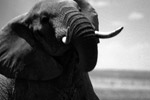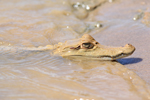During a routine Amur tiger survey with remote camera traps in December 2011, a few photos gave biologists a shock when they revealed the stunning sight of a golden eagle (Aquila chrysaetos) launching itself on the back of a 7-month old sika deer (Cervus nippon) and bringing down prey that outweighed it by at least seven times. Photographed in remote Far East Russia, the photos show an incredibly-rare instance of an eagle preying on a deer.
“I saw the deer carcass first as I approached the trap on a routine check to switch out memory cards and change batteries, but something felt wrong about it. There were no large carnivore tracks in the snow, and it looked like the deer had been running and then just stopped and died,” said lead author Linda Kerley of the Zoological Society of London (ZSL), who runs the Amur tiger camera trap project. “It was only after we got back to camp that I checked the images from the camera and pieced everything together. I couldn’t believe what I was seeing.”
Found across the northern hemisphere, golden eagles are the most widely-ranging eagles on the planet. Although big raptors, they only weigh around 9-14 pounds compared to young sika deer which weigh in at around 88-100 pounds. Despite the size difference, Kerley told NPR that indications showed that the deer was likely killed quickly. Although rare, the predation of golden eagles on deer is not wholly unheard of.

Young sika deer carcass found by Kerley. Photo by: Linda Kerley.
“The scientific literature is full of references to golden eagle attacks on different animals from around the world, from things as small as rabbits–their regular prey–to coyote and deer, and even one record in 2004 of an eagle taking a brown bear cub,” says co-author Jonathan Slaght with the Wildlife Conservation Society (WCS). And the list goes even further including instances of golden eagles preying on reindeer, red deer, roe deer, pronghorn, mountain goats, saiga, and Siberian ibex. However this is the first recorded instance of a golden eagle tackling a sika deer.
“In fact, this may be the first documentation of Golden Eagle predation of any ungulate species in the Russian Far East,” the scientists write, adding that, “[since] most Golden Eagle attacks documented elsewhere have occurred in open spaces, the fact that this predation occurred in a forest was also noteworthy.”
Still such attacks are described as opportunistic and incredibly uncommon.
“I’ve been assessing deer causes of death in Russia for 18 years–this is the first time I’ve seen anything like this,” notes Kerley.
Camera trap photos in order of sequence:

Golden eagle launches itself onto deer in Lazovskii State Nature Reserve. Photo by: Linda Kerley.

Deer appears to struggle to free itself. Photo by: Linda Kerley.

The deer appears to be flagging. Photo by: Linda Kerley.
Citations:
- Kerley, L.L. and Slaght, J.C. 2013. First documented predation of sika deer (Cervus nippon) by golden eagle (Aquila chrysaetos) in Russian Far East. Journal of Raptor Research 47: 328-330. doi: 10.3356/JRR-12-00008.1
Related articles
Bornean orangutans travel along the ground

(09/12/2013) A recent study of forest in East Kalimantan, Borneo has found that orangutans travel on the ground far more often than expected. The study, published in the American Journal of Primatology, was carried out in Wehea Forest involving the use of 78 camera traps across 38 square kilometres of forest.

(09/12/2013) Africa’s elephant poaching crisis doesn’t just threaten a species, but imperils one of humanity’s most important links to the natural world and even our collective sanity, according to acclaimed photographers and film-makers, Cyril Christo and Marie Wilkinson. Authors of the book Walking Thunder – In the Footsteps of the African Elephant, Christo and Wilkinson have been documenting Africa’s titans in photos and film for several years. In 2011, the pair released a film Lysander’s Song (named after their son an avid fan of elephants) which depicts the millennial-old relationship between humans and elephants.
Scientists discover that threatened bird migrates entirely within Amazon Basin

(09/11/2013) When one thinks of bird migrations, it’s usually a north-south route that follows seasonal climates. But researchers in the Amazon have tracked, for the first time, a largely-unknown long-distance migration that sticks entirely to the Amazon Basin. Using satellite telemetry, scientists tracked a pair of Orinoco geese (Neochen jubata) from Peru and a male from Western Brazil, who both migrated to the Llanos de Moxos, a vast savanna and Amazonian watershed in Bolivia. The research has shown that the Orinoco geese—which breeds in both Peru and Brazil—depends on wetlands in the Llanos de Moxos for much of the year.
Video: scientists discover new walking shark species in Indonesia
(09/11/2013) A species of shark that uses its fins to ‘walk’ along the bottom of the ocean floor has been discovered off the coast of Indonesia. The shark, Hemiscyllium halmahera, uses its fins to wiggle along the seabed and forage for small fish and crustaceans, scientists from Conservation International said on Friday.
Scientists discover that even crocs have a fetish for fruit

(09/10/2013) It is hard to reconcile visions of a sharp-toothed, scaly, and ferocious crocodile with anything other than a completely carnivorous diet. We have been bombarded with gory kill scenes in which crocodiles take down everything from impala to buffalo, but new evidence suggests we need to rethink crocodilians altogether.
Scientists catch boa constrictor eating a howler monkey (photos)

(09/02/2013) In a world first, scientists have captured images and video of a boa constrictor attacking and devouring whole a femle howler monkey, one of the largest new world primates weighing in at around 4 kilograms (8.8 pounds). The rare predation event was recorded in a tiny forest fragment (2.5 hectares) in the Brazilian state of Rondonia by Erika Patricia Quintino, a PhD student at the Pontifical Catholic University of Rio Grande do Sul.